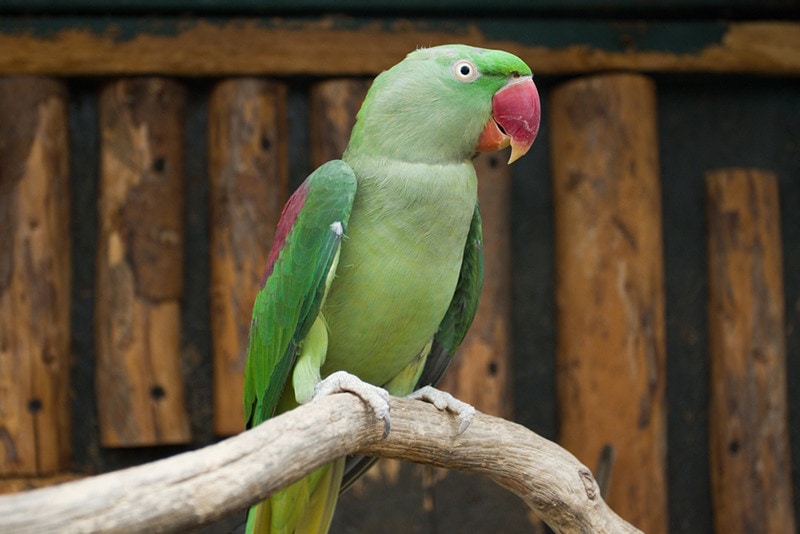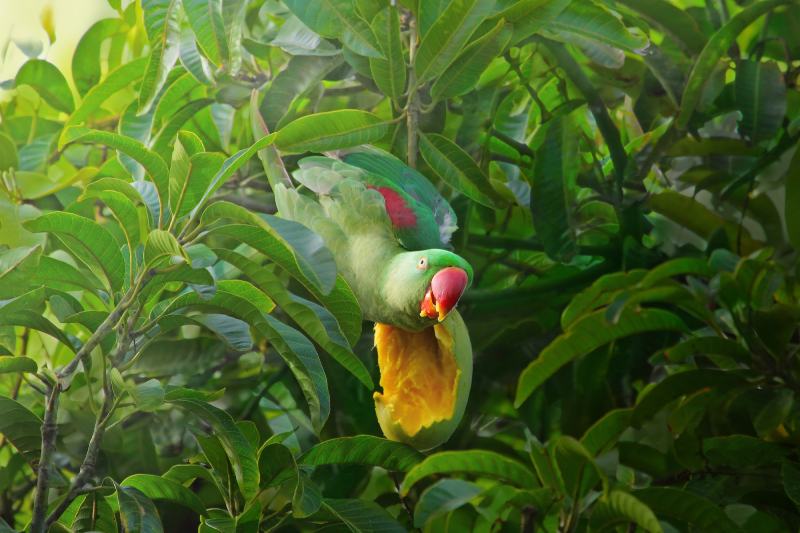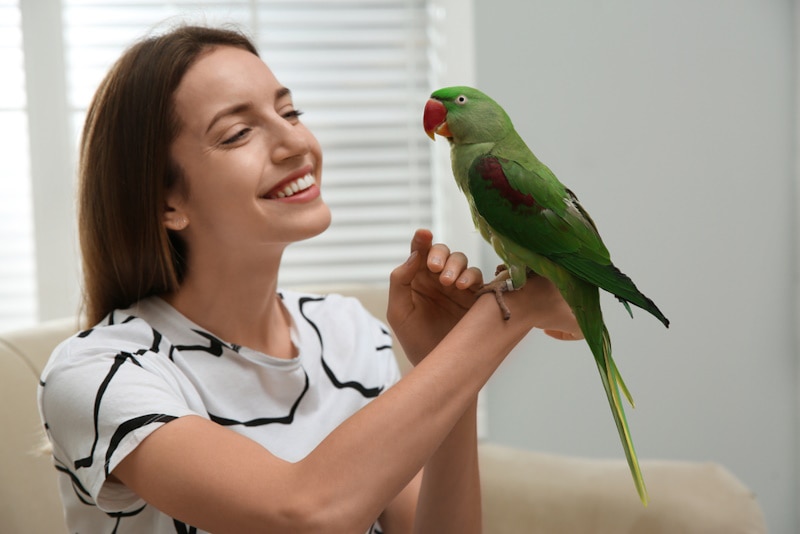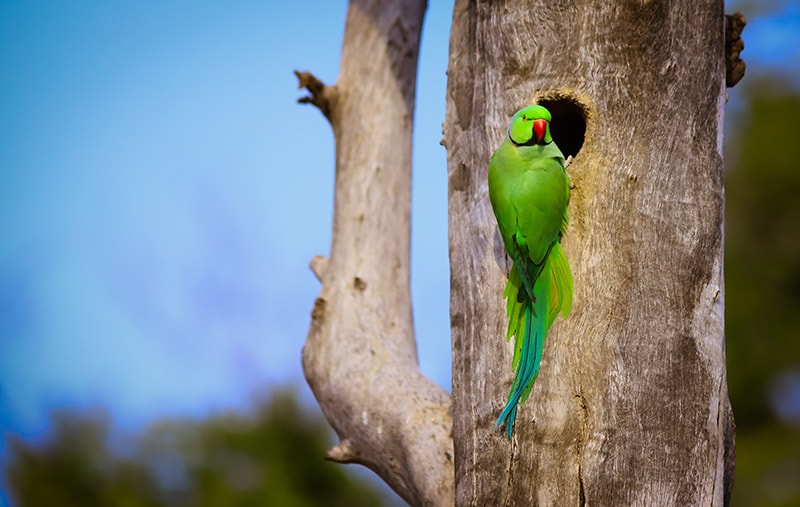Alexandrine Parakeet: Pictures, Personality, Food & Care Guide
By Adam Mann
Updated on

Click to Skip Ahead
If you want a colorful and vocal bird, the Alexandrine Parakeet is a phenomenal choice. They’re noisy birds, but they can also imitate a ton of noises and are incredibly loving. They bond strongly with one person, and they really won’t get along with everyone else in the home.
Still, they’re beautiful birds you can train a ton, and they’re among the most popular bird species to own!
Species Overview
| Color: | Green, red, and white |
| Size: | 22 to 24 inches long |
| Weight: | 7.1 to 10.6 ounces |
| Wingspan: | 7.5 to 8.5 inches |
The Alexandrine parakeet is a medium-sized parrot with bright colors and an energetic yet loving temperament. They make amazing pets, and compared to other larger birds, they can have a sweeter temperament. They’re also great at imitation, which is one of the key features many people love about these beautiful birds.
Alexandrine Parakeet Bird Characteristics
History & Natural Habitat
The Alexandrine parakeet originally hails from the forests of India and Sri Lanka and can live at elevations up to 3,000 feet. People have tamed these birds for a long time, and Alexander the Great actually transported these birds to Europe over 2,300 years ago.
Today you can find feral populations of these birds throughout India, Sri Lanka, Spain, England, Belgium, the Netherlands, Iran, Hong Kong, and Turkey. In the wild, they’re extremely loud birds but also intelligent enough to thrive and adapt to all sorts of different environments.
Things to Know When Owning an Alexandrine Parakeet
Before you bring an Alexandrine parakeet into your home, there are a few different things you should know. With that in mind, we’ve highlighted some of the basics down below.

Temperament
While you’ll need to take the time to bond with your Alexandrine parakeet, once you do this, they make great companions. They tend to bond strongly to one person, though, so if you’re looking for a bird that will bond with the entire family, they aren’t a great choice. Not only will they favor one person more, but they’ll actually shun other members of the family.
However, while they’re generally fun birds to interact with, when they go through their adolescent years, it can be a bit more challenging. Typically, this range falls between 4 months and 1 year.
Sounds, Speech & Vocalizations
Alexandrine parakeets are noisy birds, which can be both a perk and a drawback, depending on your circumstances. If you live close to other people or in an apartment building, it can be a problem, but if you want a bird that can imitate human speech, they’re a wise choice.
Just know that these birds’ noises will travel and can create problems if you live close to other people. This is not a behavior you can train out of them, so ensure their loud noises won’t create any issues with the neighbors.
Alexandrine Parakeet Appearance
While some parakeet breeds have many variations, that’s not the case with the Alexandrine parakeet. This bird can reach 25 inches in length, and most of this length comes from their long tail feathers.
These parrots are predominantly green, but they do have a few different color markings throughout their body. They have blue-grey on their cheeks and the back of the neck, a splash of yellow on their abdomen, and red patches on their shoulders.
Meanwhile, their beak is red and has yellow tips, and they have a bit of yellow on the underside of their tail. Males have a black and rose-colored ring around their neck, and females do not have these markings.
Caring for the Alexandrine Parakeet
Once you bring an Alexandrine parakeet into your home, it’s important to know how to take care of them. From what they need to eat to the size of the cage they need, you want to come ready so that you’re not rushing around at the last minute trying to figure things out.

Diet & Nutrition
One of the most important things to get right for your Alexandrine parakeet is their diet, but fortunately, it’s fairly easy to meet. Start with ¼ to ½ cup of commercial pellets meant to meet all your Alexandrine parakeet’s dietary requirements and then fill in any other potential gaps.
From there, they need ¼ to ½ cups of fresh fruits and vegetables daily. They need lots of dark leafy greens, grains, healthy seeds, and tree nuts. Feed them enough food that they can eat in 10 to 15 minutes, then remove uneaten foods to prevent spoilage.
Cage/Housing Requirements
The more space you can give an Alexandrine Parakeet, the better, but at a minimum, they need a cage at least 3 feet tall and 2 feet long and wide. But it’s important to note that this is the minimum cage size for an Alexandrine parakeet, and the more space you can give them, the happier they’ll be.
Moreover, keep in mind that getting a cage that’s an adequate size or larger doesn’t eliminate or even reduce the need to get them out of their cage and spend a little more time with them.
Exercise
Alexandrine parakeets are active birds that require lots of daily exercise. At a minimum, these birds need 3 to 4 hours each day in an area where they can fully stretch their wings and exercise outside their enclosure.
However, not only do these birds need this time outside their enclosure, but they also benefit from a large flight cage where they can fly around a bit and flap their wings. While this isn’t absolutely necessary, it will lead to a happier bird.

Health & Conditions
Most of the time, Alexandrine parakeets are healthy birds, but there are a few health concerns you should keep an eye out for. But if you keep their enclosures clean and give them plenty of exercise, you can mitigate most of these conditions.
- Psittacosis
- Aspergillosis
- Upper respiratory diseases
- Feather plucking
- Polyomavirus
- Hepatic lipidosis
- Atherosclerosis
- Cancer
3 Little-Known Facts About the Alexandrine Parakeet
1. They Get Their Name from Alexander the Great
Alexander the Great died in 323 BC, but today, every Alexandrine parakeet gets their name from this ancient figure. He brought this bird to Europe during his lifespan, and that’s why he’s still their namesake over 2,000 years later.

2. In the Wild, They Are Independent as Early as 3 Months
From hatching to independence in just 3 months shows how quickly these birds grow up in the wild. In captivity, it’s clear they’re not full adults at this age, though, as they go through adolescence, and can be a bit more temperamental until they become full adults at about 1 year old.
3. They Are “Near Threatened” in the Wild
While the Alexandrine parakeet isn’t endangered yet, they’re also a threatened species. “Near threatened” falls two steps above endangered, and it’s just under “least concern.” It’s enough to worry, but it’s not so worrying that we expect them to disappear anytime soon!
Conclusion
Now that you know a little more about the Alexandrine parakeet, all that’s left is for you to get everything you need for them and then find a beautiful one to bring home. They’re great birds with big personalities, and for many people, they’re the perfect avian pet to bring into your house!
Featured Image Credit: Dan_Koleska, Shutterstock












